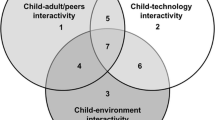Abstract
This case study evaluated the effect on cultural understanding of three different interaction modes, each teamed with a specific slice of the digitally reconstructed environment. The three interaction modes were derived from an initial descriptive theory of cultural learning as instruction, observation and action. A major aim was to ascertain whether task performance was similar to the development of understanding of the cultural context reached by participation in the virtual environment. A hypothesis was that if task performance is equivalent to understanding and engagement, we might be able to evaluate the success of virtual heritage environments (through engagement and education), without having to annoy the user with post-experience questionnaires. However, results suggest interaction in virtual heritage environments is so contextually embedded; subjective post-test questionnaires can still be more reliable than evaluating task performance.
















Similar content being viewed by others
References
Barnhart E (1998) The Palenque mapping project, 1998 field season report, FAMSI, http://www.famsi.org/reports/97024/index.html [2-15-2007]
Barnhart E (1999) The Palenque mapping project, 1999 field season report, FAMSI, 1999, http://www.famsi.org/reports/98063/index.html [2-15-2007]
Bowman DA, Kruijff E, LaViola J, Poupyrev I (2005) 3D user interfaces: theory and practice. Addison-Wesley, Boston
Foster LV (2002) Handbook to life in the ancient Maya World. Facts on File Inc., New York
Grube N (1996) Palenque in the Maya World, originally presented at the Eighth Palenque Round Table, June 6–12, 1993. In: Macri M, McHargue J (eds). Eighth Palenque Round Table, June 6–12, 1993, Pre-Columbian Art Research Institute, San Francisco, pp 1–9
Hartman J, Wernecke J (1996) The VRML 2.0 handbook, Addison-Wesley Professional, USA
Kremer J, Uc F (1996) The ritual suicide of Maya Rulers, originally presented at the Eighth Palenque Round Table, June 6–12, 1993. In: Macri M, McHargue J (eds). Eighth Palenque Round Table, June 6–12, 1993, San Francisco: Pre-Columbian Art Research Institute, pp 1–14
Oman C, Howard I, Smith T, Beall A, Natapoff A, Zacher J, Jenkin H (2003) The role of visual cues in microgravity spatial orientation. In: Buckey J, Homick J (eds) Eurolab spacelab mission: Neuroscience research in space: Results from the STS-90. Neurolab Spacelab Mission, NASA, Houston, pp 69–81
Reilly III, FK (1989) Enclosed ritual spaces and the watery underworld in formative period architecture: New observations on the function of la Venta complex A, originally presented at the Seventh Palenque Round Table in 1989, In: Fields V (ed). Seventh Palenque Round Table, 1989, Pre-Columbian Art Research Institute, San Francisco, 1994, 1–14
Ruiz R, Weghorst S, Savage J, Oppenheimer P, Furness III T, Dozal Y (2004) Virtual Reality for Archeological Maya cities. Paper presented at the Virtual Congress—World heritage in the digital age: Technology and New Media for documentation, preservation, management, sustainable tourism and education conference, from http://www.virtualworldheritage.org/index.cfm?pg=PapersProjects&l=en&confSelect=Mexico
Schele L, Mathews P (1998) The code of kings. Scribner, New York
Spero J (1994) Beyond rainstorms: The Kawak as an ancestor, warrior, and patron of witchcraft, originally presented at the seventh Palenque Round Table in 1989. In: Fields V (ed). Seventh Palenque Round Table, 1989. Pre-Columbian Art Research Institute, San Francisco, pp 1–14
Taube K (1985) The classic Maya Maize God: a reappraisal. originally presented at the fifth Palenque round table, June 12–18, 1983. In: Fields V (ed). Fifth Palenque Round Table
Acknowledgments
An Australian Research Council SPIRT grant in collaboration with Lonely Planet Publications supported this research: special thanks to Dr Ron Gallagher from Lonely Planet. Dr Graham Hepworth provided valuable statistics consulting.
Author information
Authors and Affiliations
Corresponding author
Rights and permissions
About this article
Cite this article
Champion, E., Bishop, I. & Dave, B. The Palenque project: evaluating interaction in an online virtual archaeology site. Virtual Reality 16, 121–139 (2012). https://doi.org/10.1007/s10055-011-0191-0
Received:
Accepted:
Published:
Issue Date:
DOI: https://doi.org/10.1007/s10055-011-0191-0




